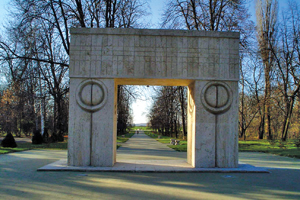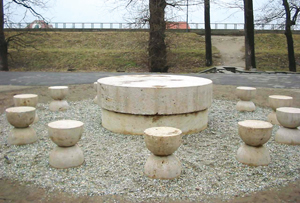Battle over the heritage to Brancusi
Wonder why there are no models or t-shirts of Brancusi in Romania? Copyright law places the reproduction of his work out of the hands of its owners, finds Anca Pol
 In 1927, a version of sculptor
Constantin Brancusi’s sculpture ‘The
Bird in Space’ was transported from
Europe to the American continent, following
its purchase by an American for
600 USD. Seeing the lean and simple
abstract figure, the American customs
clerks labelled the merchandise ‘industrial
object’ and charged the buyer a 40
per cent import tax.
In 1927, a version of sculptor
Constantin Brancusi’s sculpture ‘The
Bird in Space’ was transported from
Europe to the American continent, following
its purchase by an American for
600 USD. Seeing the lean and simple
abstract figure, the American customs
clerks labelled the merchandise ‘industrial
object’ and charged the buyer a 40
per cent import tax.
Irritated, Brancusi sued the American
customs department and won, proving
that the piece was real art and not, say,
a spare part for a train undercarriage or
printing press.
Last year a version of the industrial
object was sold at Christie’s New York
for over 27 million USD, becoming the
most expensive work of art ever sold at
auction. But, 50 years on from his death,
Brancusi’s works are still the subject of
many legal disputes.
While Brancusi may be the most famous
sculptor of the 20th century and
Romania’s most illustrious international
artist, his work cannot be reproduced or
used in advertising or promotion without
the consent of his heir and a legal team
for now and decades
to come.
Brancusi lived
and worked in Paris
from the beginning
of the 20th century
until the 1950s,
while retaining his
Romanian citizenship.
He was in his
70s when he decided
to come to Romania
and offered the then
Communist state the
copyright for all his work. However, after
examining the offer, the Romanian
Academy said his work was too ‘decadent’
for a country where Proletarian art
was at its peak.
Hurt and disappointed, Brancusi returned
to France, where he applied for
and received French citizenship. Anger
at this snub was further compounded
when Brancusi left his studio to the
French state. This Atelier now stands in the shadow of the Centre Pompidou in
the heart of Paris.
At the same time, he appointed two
Romanian artists, Natalia Dumitrescu
and Alexandru Istrati, husband and
wife, as legal heirs. They came to Paris
on an arts scholarship and helped assist
Brancusi during his
final days.
At Dumitrescu’s
death in 1997, her
nephew Theodor
Nicol, a Canadian
citizen of Romanian
origin, took over the
rights to the international
copyright
of Brancusi’s work
and its reproduction.
Regarding the legality
of Nicol’s claim, Doina Lemny,
researcher at the Pompidou Centre and
Brancusi expert says: “There is no doubt
about it.”
Adds Paris lawyer Jean-Marc Sabatier: “Mr Nicol can ask for royalty costs for
the reproduction of Brancusi’s work in
France.”
Nicol tells The Diplomat he has no
property rights over Brancusi’s works in
general, but the owners of these works,
such as individuals or institutions, do
not have copyright, including rights to
reproduce the art in the audiovisual,
multimedia or editorial formats.
Targu Jiu, the nearest city to Constantin
Brancusi’s native village Hobita, hosts
three outdoor sculptures by Brancusi:
the Infinity Column, the Gate of the Kiss
and the Table of Silence. These were
dedicated to the Gorj County heroes of
the First World War and the Association
of Gorj Women (Femeile Gorjene), the
first owners of the three works, donated
them to the Targu Jiu Municipality.
Five years ago, the sculptures were
surrounded by broken beer glass and
cigarette butts, with no guards. Now,
a visitor can admire the three works at
their best, after the World Bank financed
their restoration.
But there are no T-shirts with a picture
of the Gate, neither pencil sharpeners
emblazoned with the image of the column,
nor gift shops. In short, the City
Hall is not and, arguably, cannot, capitalise
on its ownership of these works.
“It is not acceptable,” says Sorin
Buliga, director of the Constantin
Brancusi Culture and Art Centre in
Targu Jiu, the cultural branch of the local
municipality. “I cannot sell anything
bearing images of Brancusi’s works and everyone criticises us for this.”
Targu Jiu-based Brancusi author Ion
Mocioi argues that the City Hall is the “absolute owner” of the three works. He also thinks that intellectual property
law should not apply in this case because
Brancusi received “no money” for the
creation of the masterpieces.
However the Targu Jiu Municipality,
as current owner of the three pieces,
started to collect money for the Brancusi
copyright in Romania, bypassing the
Romanian association appointed to collect
royalties for artists - Visarta. In
2002 the City Hall charged an advertising
agency 3,000 USD to use the image
of the Infinity Column in a soft drink
commercial.
“They wanted to make some money,”
said Gheorghe Voican, executive director
of Visarta.
That year Visarta sued the City Hall.
This has passed through various judicial
bodies, from the Targu Jiu Court to the
Supreme Court, where the case continues.
“We do not understand why we
cannot use the images of the works,
since they are in our direct property,”
says Buliga.
Paris-based Sabatier says a distinction
must be made between
the material property and the patrimonial
or intellectual rights. “A
museum can expose a work of art it
has acquired, with the condition of
not reproducing it,” he adds.
French and Romanian intellectual
property laws remain similar, says
lawyer Mihaela Giuraniuc. “During the
copyright protection period, the owner
of the work of art, individual, gallery,
museum, cannot reproduce the work,
inclusive through photographing and
filming without the preliminary agreement
of the copyright holder.”
To protect against potential litigation,
galleries and museums often place signs
warning that the photographing, filming
or any form of reproduction is prohibited.
The Art Museum of Craiova owns and
displays six works by Brancusi.
“It is normal to have to pay royalty for
these images,” says Florin Rogneanu,
director of the museum.
Visarta represents the French-based
owner of Brancusi’s royalties, the
Association of the Authors in Graphic
and Plastic Arts (ADAGP). When it
comes to approving the use of Brancusi
images, Voican says nothing can be done
without the approval of ADAGP Paris
and this French association,
at its turn,
does nothing without
Nicol’s approval.
“If you break
this, it’s a crime,” he
adds.
Many want to use
images of Brancusi’s
works for different
purposes, such as in models for sale.
Voican says a former Hunedoara prefect
thought he could create a mould replica
of the Infinity Column because he had
in his possession Brancusi’s plans for the
sculpture.
BANG TO RIGHTS
 Visarta has come up against some resistance.
Visarta has come up against some resistance.
“I have even been threatened to be
shot by a publishing house director, who
said to me: ‘Who do you think you are? I
don’t want to pay!’,” he adds.
All the cases requesting the use of
Brancusi images are treated case by
case. The users of the image send details
to Visarta and, according to this, a price
is calculated.
“The law allows me to negotiate,”
Voican says.
Only the owner of the copyright can
decide gratuity or a preferential price.
According to Buliga, he intends to ask
for Theodor Nicol’s permission to make
an exception for Targu Jiu. This means
not charging the Municipality for using
the images of the Infinity Column, Gate
of Kiss and Table of Silence in its promotion.
There have been cases, such as the
publication of two books about Brancusi,
where Nicol has offered the approval for
free, only a commission for Visarta was
collected.
“When it is done in cultural purposes
we make reductions,” the Visarta general
director tells The Diplomat.
In 2002, Theodor Nicol went to
the Romanian
Ministry of
Culture and said
that he had no
financial requirements
and that
all he wanted was
for Brancusi’s
works not to be
used in other purposes
than what they were created for.
This ignored the fact that the Ministry
had allotted some money as a budget
for Brancusi royalty costs during the
Brancusi Year.
With the 11th Francophony Summit
hosted this year in Romania, the international
reunion’s logo, designed by graphic
artist Octavian Penda, will comprise the
image of ‘The Cock’ by Brancusi. As we
went to press, an approval in principal
had been given by ADAGP Paris. “The
price has not been established yet,” says
Voican. “As for these matters you cannot
establish a price per kilo.”
| IMAGE CONSCIOUS |
The Romanian Government is
still working out whether or not
it wants to rebrand its country
(see The Diplomat, vol 2, no. 1)
and some marketing specialists
want to use Brancusi’s work to
promote the best of Romania but,
as they understood it, they were not
allowed. But if Theodor Nicol, the owner of the Brancusi copyright, gives the approval, it can be done. On the subject of using certain images of some of Brancusi’s well-known works for a projected campaign of ‘country branding’, Nicol says: “An overall answer to this question cannot be given upfront, due to the fact that each request has to be analysed and handled separately, according to its specificity and the copyright legislation in effect.” He says this will be individually assessed through the legal channels. “Respecting the spirit of the oeuvre and the image of the artist will be an essential factor in taking the final decision for granting an authorisation,” he adds. |
